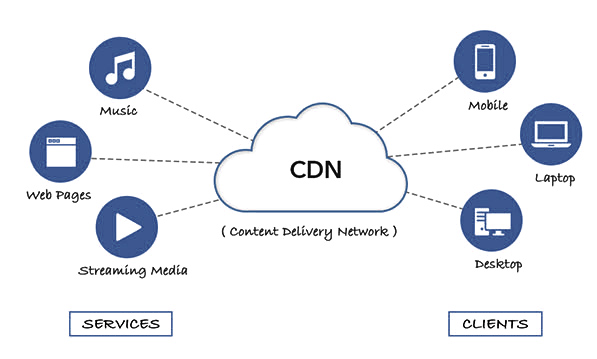In today’s digital age, where the speed and responsiveness of websites can make or break user experience and business success, Content Delivery Networks (CDNs) play a crucial role. From improving loading times to enhancing reliability and global reach, CDNs have become indispensable tools for web developers, businesses, and content providers alike. This comprehensive article explores the myriad ways CDNs contribute to website speed and performance optimization.
Understanding Content Delivery Networks (CDNs)
A Content Delivery Network is a distributed network of servers strategically positioned across various geographical locations. The primary goal of a CDN is to deliver web content to users more efficiently by reducing latency, minimizing the distance between the user and the server hosting the content, and optimizing the delivery process. CDNs typically cache content such as images, videos, scripts, and other static assets, ensuring faster access and reduced load times for end-users. Web page performance test help you to monitor your website performance.
Key Benefits of CDNs for Website Speed Optimization
-
Reduced Latency and Faster Loading Times:
- CDNs store cached versions of content closer to users, significantly reducing the time it takes for data to travel between the server and the user’s device. This proximity minimizes latency, resulting in faster loading speeds.
- By serving content from nearby servers, CDNs bypass internet congestion and routing issues that can slow down traditional server-to-client content delivery.
-
Improved Website Performance Across Different Devices and Locations:
- With a global network of servers, CDNs ensure consistent performance across various devices and geographic regions. Whether a user accesses a website from New York or Tokyo, CDNs optimize content delivery based on the nearest server, ensuring a seamless experience.
- This capability is particularly crucial for businesses with an international audience, as CDNs help maintain high performance levels irrespective of geographical distance.
-
Enhanced Scalability and Handling of Traffic Spikes:
- During periods of high traffic or sudden spikes in demand (e.g., due to viral content or marketing campaigns), CDNs distribute the load across multiple servers. This load balancing feature prevents server overload and ensures uninterrupted access to website content.
- By scaling resources dynamically, CDNs help websites maintain optimal performance even under unpredictable traffic conditions, improving overall reliability and user satisfaction.
-
Optimization of Content Delivery for Dynamic and Static Assets:
- CDNs efficiently cache both static assets (e.g., images, CSS files) and dynamic content (e.g., personalized web pages, real-time updates), optimizing the delivery of both types of content based on user requests.
- This hybrid caching approach ensures that frequently accessed content is readily available from the nearest edge server, while dynamic content remains up-to-date and responsive.
-
Security Enhancements and DDoS Mitigation:
- Many CDNs offer built-in security features such as DDoS (Distributed Denial of Service) protection, SSL/TLS encryption, and web application firewalls (WAFs). These security measures safeguard websites against malicious attacks and unauthorized access attempts.
- By filtering incoming traffic and detecting potential threats at the edge of the network, CDNs enhance the overall security posture of websites without compromising performance.
Implementing CDNs: Best Practices and Considerations
-
Choosing the Right CDN Provider:
- Evaluate CDN providers based on their global reach, network performance, pricing structure, and additional features such as security and analytics.
- Consider the specific needs of your website (e.g., content types, traffic patterns) to select a CDN provider that aligns with your performance and scalability requirements.
-
Configuring CDN Settings for Optimal Performance:
- Customize caching rules and content expiration settings to maximize the efficiency of content delivery.
- Leverage HTTP/2 and other optimization techniques supported by CDNs to further enhance loading speeds and responsiveness.
-
Monitoring and Analyzing CDN Performance:
- Utilize CDN analytics tools to track key performance metrics such as latency, bandwidth usage, and content delivery times.
- Regularly monitor CDN performance to identify opportunities for optimization and ensure consistent delivery of high-quality user experiences.
Case Studies and Real-World Examples
- E-commerce Platforms: Retailers use CDNs to deliver product images and videos quickly to online shoppers, reducing bounce rates and improving conversion rates.
- Media and Entertainment: Streaming services leverage CDNs to deliver high-definition video content seamlessly to global audiences, minimizing buffering and playback interruptions.
- Corporate Websites: Multinational corporations use CDNs to maintain fast and reliable access to corporate communications and resources across distributed offices and remote workers.
Future Trends and Innovations in CDN Technology
- Edge Computing Integration: CDNs are evolving to support edge computing capabilities, enabling the execution of compute-intensive tasks closer to end-users for enhanced performance and interactivity.
- AI-driven Optimization: AI and machine learning algorithms are being integrated into CDNs to dynamically optimize content delivery based on user behavior and network conditions.
Conclusion
In conclusion, Content Delivery Networks (CDNs) are indispensable tools for enhancing website speed, performance, and reliability. By leveraging a global network of distributed servers, CDNs minimize latency, optimize content delivery, and improve user experiences across diverse devices and geographic locations. As digital content consumption continues to grow, CDNs will play an increasingly vital role in supporting the seamless delivery of web applications, multimedia content, and dynamic digital experiences. Embracing CDNs empowers businesses to stay competitive in a fast-paced digital landscape while meeting the expectations of today’s demanding online users.
Through continuous innovation and integration with emerging technologies, CDNs will continue to evolve, driving further improvements in website speed and performance for years to come.




